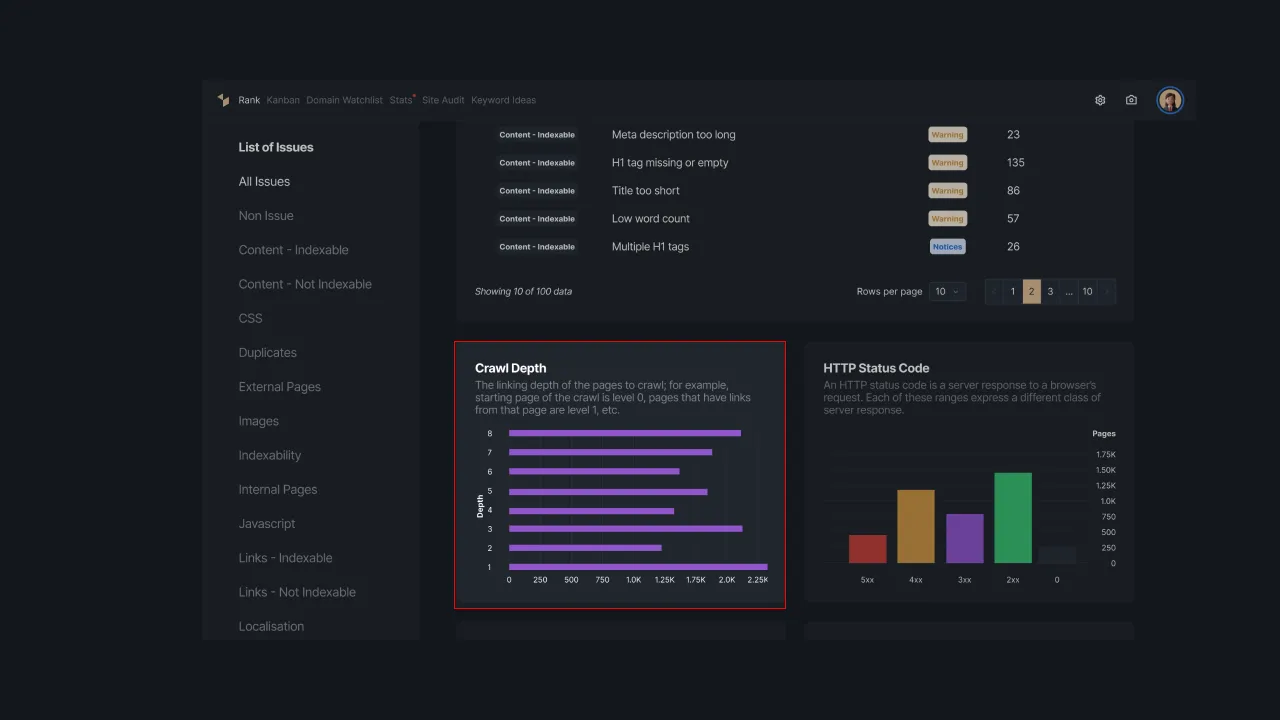What Is Crawl Depth and How Does It Impact SEO?
In terms of search engine optimization (SEO), a term that often surfaces is "crawl depth." This seemingly technical aspect plays a significant role in determining how search engines index and rank your website's content.
In this article, we'll delve into the concept of crawl depth, its importance in the realm of SEO, and how it influences the overall visibility and performance of your website.
What is Crawl Depth?
Crawl depth refers to the level at which a particular page on your website is located from the homepage or the root domain. In simpler terms, it's a measure of how many clicks it takes for a search engine crawler to reach a specific page from the homepage.
Pages that are easily accessible, usually within a few clicks from the homepage, are considered to have shallow crawl depth, while those buried deeper in the site structure have a higher crawl depth.
Let's consider a hypothetical website for an IT consulting firm to illustrate the concept of crawl depth:
Homepage:
- The homepage of the IT consulting firm's website (www.exampleconsulting.com) is the starting point.
- The homepage contains links to key service pages like "IT Consulting Services," "Network Security," and "Cloud Solutions.”
Crawl Depth Example:
1. Service Page 1: IT Consulting Services
- URL: www.exampleconsulting.com/it-consulting
- This page is directly linked to the homepage, making it easily accessible.
- Crawl Depth: 1 (shallow)
2. Service Category Page: Security Solutions
- URL: www.exampleconsulting.com/security-solutions
- This page is linked from the homepage under a broader category.
- Crawl Depth: 2 (Moderate)
3. Subcategory Page: Firewall Solutions
- URL: www.exampleconsulting.com/firewall-solutions
- This page is linked from the Security Solutions page.
- Crawl Depth: 3 (deeper)
4. Specific Service Page: Managed Firewall Services
- URL: www.exampleconsulting.com/managed-firewall-services
- This page is linked from the Firewall Solutions page.
- Crawl Depth: 4 (deeper)
In this example, the crawl depth increases as we move further away from the homepage. Pages related to specific services are nested within broader categories and subcategories. Although these pages are still accessible, the increased number of clicks required for search engine crawlers to reach them contributes to a higher crawl depth.
Why Does Crawl Depth Matter?
You might wonder why the depth of the crawl is important to SEO. Below are the reasons why it should be optimized.
1. Indexation and Visibility
Search engines use crawlers to navigate and index the vast expanse of the internet. The crawl depth of your pages directly affects how efficiently these crawlers can discover and index your content.
Pages with shallow crawl depth are more likely to be promptly discovered and indexed, enhancing their visibility in search engine results.
2. Link Equity Distribution
Crawl depth plays a crucial role in the distribution of link equity throughout your website. Link equity, or link juice, is the value passed from one page to another through hyperlinks. Pages with lower crawl depth, especially those linked from the homepage, tend to receive more link equity. This can positively impact their search engine rankings.
3. User Experience
Crawl depth is closely tied to the user experience. Shallow crawl depth often implies a more intuitive and user-friendly site structure, making it easier for both users and search engines to navigate. When users can easily find relevant information with minimal clicks, it contributes to a positive user experience.
How to Optimize Crawl Depth?
After knowing the importance of this metric, you need to understand how to optimize it. Below are the things to optimize to improve the crawl depth.
1. Sitemap Optimization
Ensure that your XML sitemap is well-organized and includes all essential pages. This helps search engine crawlers understand the structure of your site and prioritize indexing.
2. Internal Linking Strategy
Craft a thoughtful internal linking strategy. Include contextual links within your content, emphasizing important pages. Avoid orphan pages (pages without internal links) as they may have higher crawl depths.
3. URL Structure
Adopt a clean and logical URL structure. Avoid overly complex URLs that may hinder the crawling process. Use hyphens to separate words for improved readability.
4. Mobile Friendliness
Given the increasing emphasis on mobile-first indexing by search engines, ensure your site is mobile-friendly. A responsive design contributes to a positive user experience and can impact crawl depth.
5. Regular Monitoring
Regularly monitor your site's crawl depth using tools like Google Search Console. Identify pages with higher crawl depths and assess if adjustments to your site structure or internal linking can optimize this.
6. Do a Site Audit
The last thing to do is to conduct a Site Audit using Sequence Stats. Here, you can find the crawl depth of your URLs. From this data, you can prioritize which section of your site that should be optimized.
 |
|---|
| Picture 1 - Crawl Depth in the Sequence Stats Site Audit Result. |
Conclusion
Crawl depth is an often overlooked but crucial element in the SEO landscape. Understanding how search engine crawlers navigate your website can provide valuable insights into ways to enhance visibility, indexation, and user experience. Don’t forget to use Sequence Stats as your assistance in doing SEO.